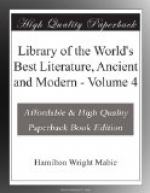The range of Sir Walter Besant reaches from the somewhat conventionalized ‘Dorothy Forster’ to ‘St. Katharine’s Tower,’ where deep tragedy approaches the melodramatic, or from the fascination of ‘The Master Craftsman’ to the ‘Wapping Idyll’ of the heaps of miser’s treasure. There is largeness of stroke in this list, and a wide prospect. His humor is of the cheerful outdoor kind, and the laugh is at foibles rather than weakness. He pays little attention to fashion in literature, except to give a good-natured nod to a passing fad.
It would be difficult to classify him under any school. His stories are not analytical, nor is one conscious of that painstaking fidelity to art which is no longer classed among the minor virtues. When he fights, it is with wrong and oppression and the cheerless monotony of the lives of the poor; but he fights classes rather than individuals, although certain characters like Fielding the plagiarist, in ’Armorel of Lyonesse,’ are studied from life. The village of bankrupts in ’All in a Garden Fair’ is a whimsical conceit, like the disguise of Angela in ’All Sorts and Conditions of Men,’ and the double identity of Edmund Gray in ‘The Ivory Gate.’ In reading Besant we are constantly reminded that humanity is wider than the world; and though its simplest facts are its greatest, there is both interest and edification in eccentricities.
In 1895 he was made a baronet, and is president of the Society of Authors, of whom he has been a gallant champion against the publishers.
OLD-TIME LONDON
From Sir Walter Besant’s ‘London’: Harper and Brothers
The London house, either in Saxon or Norman time, presented no kind of resemblance to the Roman villa. It had no cloisters, no hypocaust, no suite or sequence of rooms. This unlikeness is another proof, if any were wanting, that the continuity of tenure had been wholly broken. If the Saxons went into London, as has been suggested, peaceably, and left the people to carry on their old life and their trade in their own way, the Roman and British architecture—no new thing, but a style grown up in course of years and found fitted to the climate—would certainly have remained. That, however, was not the case. The Englishman developed his house from the patriarchal idea.
First, there was the common hall; in this the household lived, fed, transacted business, and made their cheer in the evenings. It was built of timber, and to keep out the cold draughts it was afterwards lined with tapestry. At first they used simple cloths, which in great houses were embroidered and painted; perches of various kinds were affixed to the walls, whereon the weapons, the musical instruments, the cloaks, etc., were hung up. The lord and lady sat on a high seat; not, I am inclined to think, on a dais at the end of the hall, which would have been cold for them, but on a great chair near the fire, which was burning in the middle of the hall. This fashion long continued. I have myself seen a college hall warmed by a fire in a brazier burning under the lantern of the hall. The furniture consisted of benches; the table was laid on trestles, spread with a white cloth, and removed after dinner; the hall was open to all who came, on condition that the guest should leave his weapons at the door.




